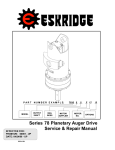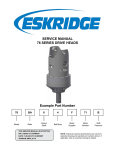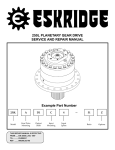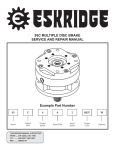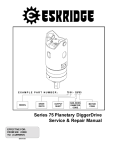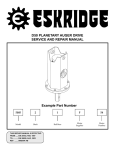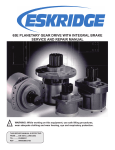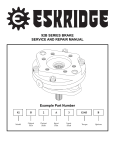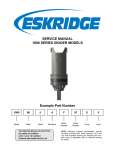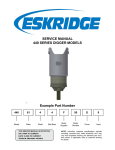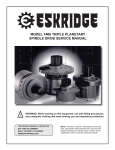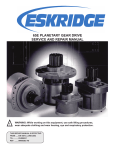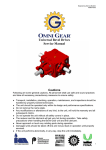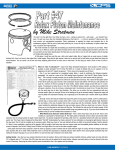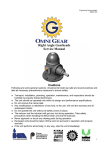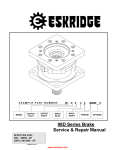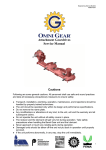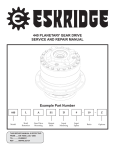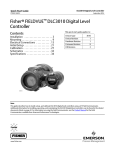Download 100e single/double stage planetary gear drive service
Transcript
EXAMPLE PART NUMBER: 100 MODEL GEARDRIVE MOUNTING OUTPUT SHAFT INPUT MOUNTING E INPUT SPLINE D1 C 4 - 35 Z RATIO OPTIONS 100E SINGLE/DOUBLE STAGE PLANETARY GEAR DRIVE SERVICE & REPAIR MANUAL THIS SERVICE MANUAL IS EFFECTIVE FROM: .......... S/N 17802, AUG. 1995 TO: ............... CURRENT REF: .............. SM100ED2-AA 100E SERVICE MANUAL SINGLE AND DOUBLE STAGE PLANETARY GEAR DRIVE This manual will assist in disassembly and assembly of the above model planetary geardrives. Item numbers, indicated in parentheses throughout this manual, refer to the exploded parts breakdown drawing. Individual customer specifications (mounting case, output shaft, brake assembly, etc.) may vary from exploded drawing and standard part numbers shown. If applicable, refer to individual customer drawing for details. For any spare or replacement parts, contact your distributor or equipment manufacturer. Always try to have available the geardrive unit part number, serial number and date code on the serial tag. This information may be necessary for verification of any component part numbers. Component part numbers and/or manufacturing lot numbers may be stamped on individual parts. This information may also be helpful in identifying replacement components. LUBRICATION & MAINTENANCE Change the oil after the first 50 hours of operation. Oil should be changed at 500 hour intervals thereafter. Use a GL-5 grade EP 80/90 gear oil (EP = “Extreme Pressure”). The geardrive should be partially disassembled to inspect gears and bearings at 1000 hour intervals. If your unit was specified “shaft up” or with a “-Z” after the part number, a grease zerk was provided in the base housing. For output shaft-up operation, the output bearing will not run in oil and must be grease lubricated. Use a lithium base or general purpose bearing grease per below schedule. Over-greasing the output bearing in a output shaft pinion-up operation tends to fill the housing with grease and thicken the oil. OPERATING POSITION Horizontal Shaft Vertical Shaft ! OIL CAPACITY 2.25 pints (1.1 liters) 2.50 pints (1.2 liters) OIL LEVEL To horizontal centerline of gear drive To midway on upper/primary gearset WARNING: While working on this equipment, wear adequate protective clothing, hearing, eye, and respiratory protection. Use safe lifting procedures. CONTENTS Unit Disassembly Procedure ........................................................................... 3 Output Shaft Subassembly ........................................................................................... 3 Primary Planetary Carrier Subassembly...................................................................... 3 Secondary Planetary Carrier Subassembly ................................................................ 3 Case Subassembly........................................................................................................ 4 Unit Reassembly ................................................................................................ 4 100E Exploded View Drawing ......................................................................... 6 Eskridge Product Warranty ............................................................................. 7 Warranty Return Policy ................................................................................................. 7 Other Eskridge Products ................................................................................. 8 2 onto output shaft (13). Be sure it is seated tightly against shoulder of shaft. If old outer bearing cone (20) was removed only to replace shaft seal, it may be reused. Unit Disassembly Procedure 1) (Refer to exploded view drawing on page 6) Scribe a diagonal line across the outside of the unit from cover (6) to case (1) before disassembly to assure proper positioning of pieces during reassembly. 2) Remove magnetic pipe plug (30) and drain oil from unit. Maximum drainage occurs when oil is warm. 3) Remove eight cover bolts (23) and lockwashers (25). 4) Lift off cover (6). The input gear (12) and input thrust washer (17) may be lifted out of carrier assembly. 5) Lift primary planet carrier assembly (3, 8, 10,15,18 & 27) out of case. 6) The output shaft (13) and secondary planet carrier assembly may now be removed as follows: Primary Planetary Carrier Subassembly (Items 3, 8, 10, 15, 18 & 27) 1) Drive roll pins (27) into planet shafts (8). 2) Press or drive planet shafts out of carrier (3). 3) Slide planet gears (10) along with planet washers (15) out of primary carrier (3). 4) b) Loosen but do not remove shaft retaining capscrews (24). If planet bearings (18) must be replaced, they may now be pressed out of primary planet gears (10). 5) NOTE: Care should be taken not to damage output shaft or injure your feet when shaft falls out of case. Use 1/8 inch pin punch to remove roll pins (27) from planet shafts. 6) Rebuild primary planet carrier assembly in reverse order using any needed new parts. Planet shafts (8) should be installed with chamfered end of 1/8 inch hole toward outside diameter of carrier. This will aid in alignment of holes while inserting roll pins. a) The secondary planet carrier (2) spline is a press fit onto output shaft (13) spline. Case (1) should be set on a plate or table with output shaft protruding downward through hole in table. c) Press output shaft out bottom of case by applying press load to top end of capscrews (24). Remove capscrews to allow shaft to pass through case. Secondary Planetary Carrier Subassembly d) Remove shim(s) (14) from top end of shaft (13). (Items 2, 5, 7, 9, 15, 19, 21 & 26) 7) Secondary planet carrier assembly (2, 5, 7, 9, 15, 19, 21 & 26) may now be lifted out of case. Output Shaft Subassembly (Items 13, 29 & 31) 1) 2) Outer tapered bearing cone (20) may be removed using a gear puller. If reusing old bearing cone, do not damage roller cage by pulling on it. To replace shaft seal (29) lubricate inner lip of new seal and turn so that open side is facing upward. Slide seal down output shaft (13) all the way to gear teeth or until it fits snug over seal diameter. NOTE: Press bearing onto shaft by pressing on inner race only. Do not press on roller cage or bearing will be damaged. 3) With large end down, press outer bearing cone (20) 3 1) Disassembly procedure is the same as previous section on primary planet carrier subassembly (steps 1-4) except that the secondary planet bearings are not a press fit. Substitute these parts: secondary carrier (2), secondary planet gears (9), planet bearings (19), secondary planet shafts (7) and roll pins (26). 2) Place carrier (2) with hub down as shown above. Place bearing retainer plate (5) in bottom of carrier. Insert secondary planet gears (9). 3) Turn carrier (2) over while using the planet gears (9) to hold retainer plate (5) in place. 4) Remove one planet gear (9) and insert a cageless bearing (19). Install two washers (15) (one on either side of the planet gear). Place in carrier and install planet shaft (7) and roll pin (26). Repeat for two remaining gears. NOTE: Press bearing onto hub by pressing on inner race only. DO NOT press on roller cage or it may damage bearing. remain centered between planet gears. A certain amount of tool clearance will be necessary in order to install and torque the capscrews (24). 5) 6) Install secondary carrier assembly (2) into case (1) as follows: Rotate secondary carrier assembly back and forth until planet gear teeth (9) mesh with gear teeth in case (1). Let carrier assembly down until carrier spline touches output shaft (13) spline. Rotate carrier by hand until you are certain carrier spline has started cleanly and squarely onto shaft spline. View down through top of secondary carrier assembly through counter-bored holes in retainer plate (5). If needed, align holes in retainer plate directly over holes in the shaft and shim(s) (14). 7) Counter-bored holes should be centered between planet gears (9). Slowly press secondary carrier assembly down tightly against output shaft (13). If tapered inner bearing cone (21) on hub of secondary carrier (2) must be replaced, it may be removed using a gear puller. Then, press a new bearing cone onto hub making sure bearing shoulder is tight against hub shoulder. Case Subassembly (Items 1, 20, 22 & 30) NOTE 1: Torque at proper bearing preload will vary according to the application. At output speeds of greater than 25 RPM, preload torque (including seal drag) should be in the range of 20 to 50 in-lbs. At less than 25 RPM, torque should be 50 to 80 in-lbs. 1) Inspect inner and outer bearing cups (22 & 20) and replace if necessary. NOTE 2: Bearing preload is achieved by adjusting the number of shims (14) under the bearing retainer plate (5). 2) Clean all foreign material from magnetic drain and fill plug (30). NOTE 3: Bearing preload will be determined by measuring bearing rolling resistance which is the torque required to turn shaft (or to turn base with shaft stationary). Torque can be measured with a spring scale attached to the base. For example, with shaft stationary, if a scale is attached to the base, measuring 5 inches from the center of the gearbox and it takes 10 pounds of force to rotate base, then preload torque is 5 inch x 10 lb = 50 in-lbs. Unit Reassembly 1) (Refer to exploded view drawing on page 6) Turn case pinion side up (opposite shown above). Apply a layer of lithium grease to outer bearing cup. Place the shaft (13) into case (1) so that the shaft’s outer tapered bearing cone (20) is seated in case’s outer bearing cup (20). Tap shaft seal (29) into place. Turn case pinion side down (standing on shaft as shown above). 3) Apply a layer of lithium grease to inner bearing cup (22). 4) Carefully place shim(s) (14) over shaft, making sure the 3 holes in shim are properly aligned with those on the shaft (13). Use the same number of shims that came out of unit to allow for correct shaft bearing preload. 5) While secondary carrier (2) assembly is under press load (approx. 2 tons), measure preload torque between case (1) and shaft (13). If torque is not correct, add or remove 1 shim as required and try again. 9) Remove press load from secondary carrier (2). Install capscrews (24) and torque to 90 ft-lbs. 10) Place secondary thrust washer (4) onto center of secondary planet carrier assembly. 11) Install sun gear (11) into center of secondary planet carrier. CAUTION: Shaft is not retained at this time. 2) 8) 12) To install primary planet carrier assembly hold inside diameter of carrier (3) and rotate until planet gears line up with case gear teeth and sun gear. Assembly will drop into place. NOTE: A simple planetary such as this does not require a gear timing procedure. 13) Insert input gear (12) into unit so that teeth mesh with primary planet gears (10). 14) Place input thrust washer (17) over input gear. Rotate bearing retainer plate (5) inside secondary carrier assembly so that counter-bored holes are centered between planet gears (9). 15) Place a new o-ring (28) on bottom of cover (6). 16) Set cover (6) on top of unit and refer to scribed line for proper orientation. Install and torque eight cover bolts NOTE: It is important that the holes in the retainer plate 4 (23) with lockwashers (25) to 32 ft-lbs. 17) Check to be sure magnetic plug (30) is securely installed into side of case (1). 18) Add gear oil as specified on page 2. Correct oil level will measure to middle of primary planet gears (10) when in the vertical operating position. 19) Put pipe sealant on magnetic plug (30) and install into oil fill hole in cover (6). 20) Insert a shaft, such as an output shaft from a hydraulic motor, into input gear (12) and rotate by hand to be sure unit turns smoothly and easily. THE GEAR DRIVE IS NOW READY FOR USE. 5 100E Exploded View Drawing 6 Eskridge Product Warranty ESKRIDGE, INC. (“Eskridge”) warrants to its original purchaser (“Customer”) that new component parts/units (“Units”) sold by Eskridge will be free of defects in material and workmanship and will conform to standard specifications set forth in Eskridge sales literature current at the time of sale or to any custom specifications acknowledged by written Customer approval of drawings, SUBJECT TO THE FOLLOWING QUALIFICATIONS AND LIMITATIONS: 1. Prior to placing Units in service, the Customer shall provide proper storage such that foreign objects (e.g., rain or debris) cannot enter any Units via entry ports which are normally closed during operation. 2. The Customer must notify Eskridge in writing of any claim for breach of this warranty promptly after discovery of a defect. The warranty period shall commence when a unit is placed in service and shall expire upon the earlier of a. the expiration of twelve (12) months from the date of Commencement of Service (as defined in Paragraph 4) b. the completion of one thousand (1000) hours of service of the Units c. the expiration of six (6) months after the expiration of any express warranty relating to the first item of machinery or equipment in which the Units are installed or on which it is mounted, or d. the installation or mounting of the Units in or on an item of machinery or equipment other than the first such item in which the Units are installed or on which the Units are mounted. 3. Units shall be deemed to have been placed in service (the “Commencement of Service”) at the time the machinery or equipment manufactured or assembled by the Customer and in which the Units are installed or on which the Units are mounted is delivered to the Customer’s dealer or the original end-user, which ever receives such machinery or equipment first. 4. This warranty shall not apply with respect to Units which, upon inspection by Eskridge, show signs of disassembly, rework, modifications, lack of lubrication or improper installation, mounting, use or maintenance. 5. Eskridge makes no warranty in respect to hydraulic motors mounted on any Units. Failure of any such motor will be referred to the motor manufacturer. 6. Claims under this warranty will be satisfied only by repair of any defect(s) or, if repair is determined by Eskridge in its sole, absolute and uncontrolled discretion to be impossible or impractical, by replacement of the Units or any defective component thereof. No cash payment or credit will be made for defective materials, workmanship, labor or travel. IN NO EVENT SHALL ESKRIDGE BE LIABLE FOR INCIDENTAL OR CONSEQUENTIAL DAMAGES OF ANY KIND OR NATURE, FOR WHICH DAMAGES ARE HEREBY EXPRESSLY DISCLAIMED. 7. From time to time, Eskridge may make design changes in the component Units manufactured by it without incorporating such changes in the component Units previously shipped. Such design changes shall not constitute an admission by Eskridge of any defects or problems in the design of previously manufactured component Units. 8. All freight charges on Units returned for warranty service are the responsibility of the Customer. 1. Any part/Unit(s) returned to Eskridge must be authorized by Eskridge with an assigned return (CSR) number. 2. All Units shall be returned freight prepaid. 3. Any Units qualifying for warranty will be repaired with new parts free of charge (except for freight charges to Eskridge as provided above). 4. If Units are found to be operable, you have two options: Warranty Return Policy a. The Units can be returned to you with a service charge for inspection, cleaning, and routine replacement of all rubber components and any other Units that show wear; b. We can dispose of the Unit(s) at the factory if you do not wish it to be returned. NOTE: Any order of Units by customer shall only be accepted by Eskridge subject to the terms stated herein. Any purchase order forms used by Customer (to accept this offer to sell) which contain terms contrary to, different from, or in addition to the terms herein shall be without effect, and such terms shall constitute material alteration of the offer contained herein under K.S.A 84-2-207 (2)(b), and shall not become part of the contract regarding the sale of the Units. The foregoing warranty is the sole warranty made by Eskridge with respect to any Units and is in lieu of any and all other warranties, expressed or implied. There are no warranties which extend beyond the description on the face hereof without limiting the generality of the foregoing, Eskridge expressly disclaims any implied warranty of merchantability or fitness for any particular purpose, regardless of any knowledge Eskridge may have of any particular use or application intended by the purchaser. The suitability or fitness of the Units for the customer’s intended use, application or purpose and the proper method of installation or mounting must be determined by the customer. 7 OTHER ESKRIDGE PRODUCTS Planetary Gear Drives SERIES TORQUE RATING MAX. INTERMITTENT 20/28 SERIES 20,000 - 28,000 IN-LB 50 SERIES 50,000 IN-LB 65 SERIES 60,000 IN-LB 100 SERIES 100,000 IN-LB 130 SERIES 130,000 IN-LB 150 SERIES 150,000 IN-LB 250 SERIES 250,000 IN-LB 600 SERIES 600,000 IN-LB 1,000,000 IN-LB 1000 SERIES Multiple Disc Brakes SERIES TORQUE RATING 90B TO 4,800 IN-LB 90BA SAE B ADJUSTABLE TORQUE TO 4,800 IN-LB 92B SAE B LOW PROFILE TO 2,800 IN-LB 93 FOR NICHOLS MOTORS TO 6,100 IN-LB 95C SAE C TO 12,000 IN-LB 95W SAE C WHEEL MOUNT TO 21,000 IN-LB 98D SAE D TO 25,000 IN-LB SAE B Diggers (Planetary Auger Drives) SERIES TORQUE RATING D50 MODELS 1500, 2500 & 5000 1,500 - 5,000 FT-LB 76 MODELS BA & BC, TWO SPEED 8,000 - 12,500 FT-LB 77 MODELS BA, BC & BD 6,000 - 12,500 FT-LB 78 MODELS 35 & 48, TWO SPEED 9,000 - 12,500 FT-LB 75 MODELS 38 & 51, TWO SPEED 16,500 - 20,000 FT-LB P. O. Box 875 ! 1900 Kansas City Road ! Olathe, KS 66051 Phone (913) 782-1238 ! Fax (913) 782-4206 ! [email protected] ! www.EskridgeInc.com








